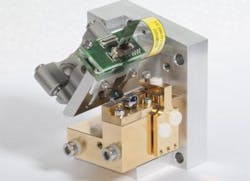Fraunhofer IPMS develops MEMS technology for spectroscopy in the mid-IR
| A QCL module for mobile mid-IR spectroscopy has an integrated MEMS diffraction grating. (Copyright Fraunhofer IAF) |
At the upcoming SPIE Photonics West trade show (7-12 February 2015; San Francisco, CA), scientists from the Fraunhofer Institute for Photonic Microsystems (Fraunhofer IPMS; Dresden, Germany) will introduce a mobile MEMS scanning grating spectrometer in "sugar cube format" for spectral analysis in the mid-infrared range (3 to 12 µm). The spectrometer can be used to study gaseous, liquid, and solid materials.
(At SPIE Photonics West 2013, the same group at IPMS had demoed a similar device, but for use in the near-IR region of 950 to 1900 nm).
In the mid-IR, many chemical substances important for security monitoring purposes (such as sensing environmental contamination, industrial accidents, or terror attacks) has unique and characteristic spectroscopic absorption lines. The small, mobile IPMS device allows different hazardous materials to be quickly detected and quantified.
To meet the device requirements, Fraunhofer IPMS and 17 other project partners from nine countries are developing a novel variable-frequency monochromatic light source for the mid-IR as part of the European joint venture research project "MIRIFISENS: Mid Infrared Innovative Lasers for Improved Sensor of Hazardous Substances."
MEMS-tunable QCL light source
The light source enables spectrometers that can detect the concentration of different hazardous materials quickly on location. The source consists of a miniaturized quantum-cascade laser (QCL) being developed by researchers of the Fraunhofer Institute for Applied Solid State Physics IAF in Freiburg. The QCL covers a large range of the wavelengths that are important for the spectroscopic "fingerprint" region in the mid-IR.
To tune the QCL, scientists at Fraunhofer IPMS developed a highly reflective diffraction grating with a diameter of 5 mm, along with control electronics. The electrostatically driven microelectromechanical-systems (MEMS)-based diffraction grating acts as the QCL's variable-frequency external resonator. It allows for the tuning of laser wavelengths over a range of up to 20% of the central wavelength.
Jan Grahmann of Fraunhofer IPMS will present the technology on 12 February 2015 in his technical session "Large MOEMS diffraction grating results providing an EC-QCL wavelength scan of 20 percent." Visitors to the accompanying exhibition can get a first-hand look at the technology by visiting the Fraunhofer IPMS' booth 4409 in the North Hall.
At the booth, IPMS will also present a further development of the scanning grating spectrometer for the near-IR range introduced two years ago. With a volume of 2.1 cm3, this system (which will be demoed distinguishing different white powders such as sugar, salt, and artificial sweetener) is controlled via a smartphone.
Source: http://www.ipms.fraunhofer.de/en/press-media/press/2015/2015-01-20.html
